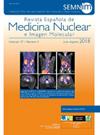Modelo para predecir riesgo de fallecimiento de causa cardíaca según características clínicas y parámetros del gated-SPECT de perfusión miocárdica
IF 1.6
4区 医学
Q3 RADIOLOGY, NUCLEAR MEDICINE & MEDICAL IMAGING
Revista Espanola De Medicina Nuclear E Imagen Molecular
Pub Date : 2025-04-03
DOI:10.1016/j.remn.2025.500132
引用次数: 0
Abstract
Background
Coronary artery disease is a complex, multifactorial process with high prevalence and morbidity-mortality. Single photon emission computed tomography (SPECT) myocardial perfusion imaging synchronized with the electrocardiogram (gated-SPECT) is a non-invasive imaging technique that has demonstrated high sensitivity and specificity for diagnosis and staging. To better predict the risk of adverse events, it is necessary to analyze the simultaneous behavior of clinical elements and diagnostic tests, a type of study that is scarce in the current literature. This research evaluated the relationship between clinical characteristics and gated-SPECT myocardial perfusion parameters with progression to cardiac death; subsequently, a model was built to predict the risk of such an outcome.
Methods
An observational, longitudinal, and retrospective study was conducted with 2 230 patients who underwent this test due to suspected coronary artery disease. Clinical characteristics, test parameters, and progression to cardiac death were collected and the relationships between them were studied. A logistic regression model was built to study the relationships between the variables and their influence on the probability of progression to cardiac death.
Results
Clinical characteristics associated with a higher probability of cardiac death were male sex (OR = 5.104, P = 0.004), peripheral arterial disease (OR = 7.175, P < 0.001), and diabetes mellitus (OR = 3.159, P = 0.013). The gated-SPECT parameters associated with a higher risk of this outcome were VTS ≥70 ml (OR = 12.257, P < 0.001), EF < 50% (OR = 10.757, P < 0.001), VTD ≥140 ml (OR = 8.884, P < 0.001), ventricular dilation (OR = 8.959, P < 0.001), and reversible defects (OR = 7.454, P = 0.001). Fixed defects, parietal motility abnormalities, the presence of both reversible and fixed defects, and the hyperdynamic gated state were also associated with a higher risk of cardiac death but with lower ORs.
The logistic regression model showed good overall performance and high ability to determine progression to cardiac death, close to perfect predictive capacity (AUC = 0.9656).
Conclusions
It is necessary to employ total cardiovascular risk models that include results from diagnostic tests such as gated-SPECT. The constructed model demonstrated good overall performance and is a valid proposal for predicting the risk of death due to cardiac causes.
根据临床特征和心肌灌注Gate -SPECT参数预测心脏死亡风险的模型
背景冠状动脉疾病是一个复杂的、多因素的过程,具有高患病率和发病率-死亡率。单光子发射计算机断层扫描(SPECT)与心电图同步心肌灌注成像(门控SPECT)是一种非侵入性成像技术,在诊断和分期方面具有很高的灵敏度和特异性。为了更好地预测不良事件的风险,有必要分析临床因素和诊断试验的同时行为,这是目前文献中很少的一类研究。本研究评估临床特征和门控spect心肌灌注参数与心源性死亡进展的关系;随后,建立了一个模型来预测这种结果的风险。方法对2 230例疑似冠状动脉疾病患者进行观察性、纵向和回顾性研究。收集临床特征、试验参数及心源性死亡进展情况,并研究它们之间的关系。建立logistic回归模型,研究各变量之间的关系及其对心源性死亡进展概率的影响。结果男性(OR = 5.104, P = 0.004)、外周动脉疾病(OR = 7.175, P < 0.001)和糖尿病(OR = 3.159, P = 0.013)与心源性死亡概率较高相关。与该结果较高风险相关的门控spect参数为VTS≥70 ml (OR = 12.257, P < 0.001)、EF < 50% (OR = 10.757, P < 0.001)、VTD≥140 ml (OR = 8.884, P < 0.001)、心室扩张(OR = 8.959, P < 0.001)和可逆缺陷(OR = 7.454, P = 0.001)。固定缺陷、顶叶运动异常、可逆缺陷和固定缺陷的存在以及高动力门控状态也与心脏死亡的高风险相关,但与较低的ORs相关。logistic回归模型整体表现良好,对心源性死亡进展的预测能力较高,接近完美预测能力(AUC = 0.9656)。结论采用包括门控spect等诊断试验结果在内的总心血管风险模型是必要的。所构建的模型整体性能良好,是预测心脏原因死亡风险的有效建议。
本文章由计算机程序翻译,如有差异,请以英文原文为准。
求助全文
约1分钟内获得全文
求助全文
来源期刊

Revista Espanola De Medicina Nuclear E Imagen Molecular
RADIOLOGY, NUCLEAR MEDICINE & MEDICAL IMAGING-
CiteScore
1.10
自引率
16.70%
发文量
85
审稿时长
24 days
期刊介绍:
The Revista Española de Medicina Nuclear e Imagen Molecular (Spanish Journal of Nuclear Medicine and Molecular Imaging), was founded in 1982, and is the official journal of the Spanish Society of Nuclear Medicine and Molecular Imaging, which has more than 700 members.
The Journal, which publishes 6 regular issues per year, has the promotion of research and continuing education in all fields of Nuclear Medicine as its main aim. For this, its principal sections are Originals, Clinical Notes, Images of Interest, and Special Collaboration articles.
 求助内容:
求助内容: 应助结果提醒方式:
应助结果提醒方式:


